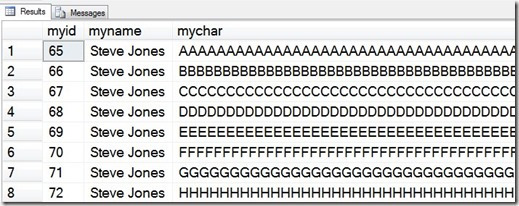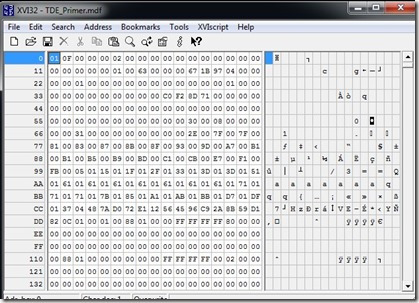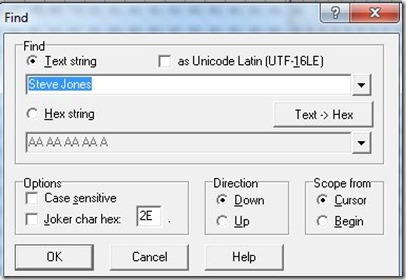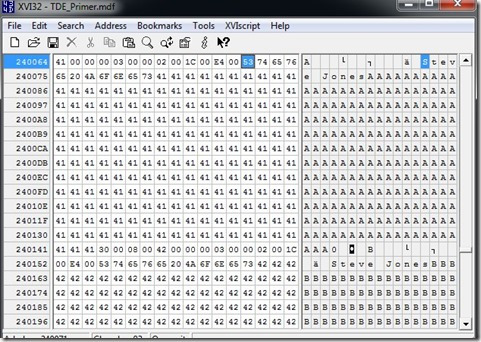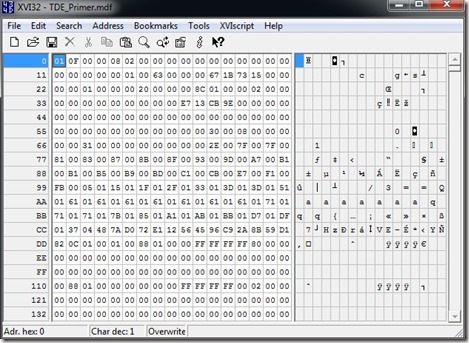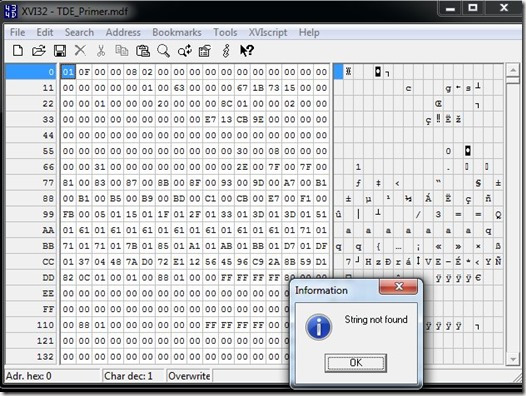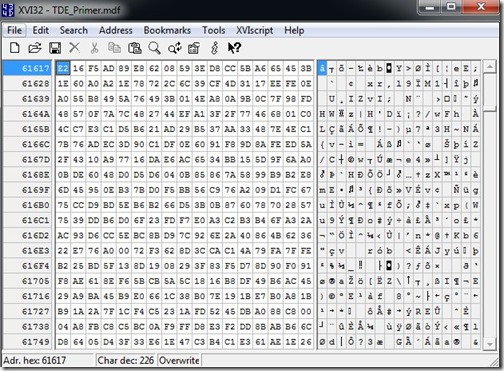Yes, it does. However, let’s prove it. First let’s create a database, a table, and enter some data:
-- create a database CREATE DATABASE TDE_Primer ; GO -- create and populate a table USE TDE_Primer go CREATE TABLE MyTable ( myid INT , myname VARCHAR(20) , mychar VARCHAR(200) ) ; go DECLARE @i INT = 65; WHILE @i < 92 begin INSERT mytable SELECT @i, 'Steve Jones', REPLICATE(CHAR(@i), 200); SELECT @i = @i + 1; END ; GO SELECT * FROM Mytable; go
If I look at the table, I see my name with lots of data:
Now let’s detach the database and examine the results with a hex editor:
-- detach database USE [master] GO EXEC master.dbo.sp_detach_db @dbname = N'TDE_Primer' ; GO
I use XVI32 as an editor. It’s free, and you can download it. If I open up my MDF in this utility, here’s what I see:
If I search for my name:
I find it:
This is what I expect, and you should as well. Even without SQL Server, your data files are readable, which is why you must protect them.
Now let’s attach the file and enable TDE.
USE [master] GO CREATE DATABASE [TDE_Primer] ON ( FILENAME = N'C:\Program Files\Microsoft SQL Server\MSSQL11.MSSQLSERVER\MSSQL\DATA\TDE_Primer.mdf' ), ( FILENAME = N'C:\Program Files\Microsoft SQL Server\MSSQL11.MSSQLSERVER\MSSQL\DATA\TDE_Primer_log.ldf' ) FOR ATTACH GO USE TDE_Primer go SELECT * FROM mytable ; go -- begin encryption setup -- from http://msdn.microsoft.com/en-us/library/bb934049.aspx USE master; GO -- create master key for master CREATE MASTER KEY ENCRYPTION BY PASSWORD = 'AlwaysU$eaStr0ngP@ssword4This' ; go -- create certificate to secure TDE CREATE CERTIFICATE TDEPRimer_CertSecurity WITH SUBJECT = 'TDE_Primer DEK Certificate'; go USE TDE_Primer; GO -- Create DEK CREATE DATABASE ENCRYPTION KEY WITH ALGORITHM = AES_128 ENCRYPTION BY SERVER CERTIFICATE TDEPRimer_CertSecurity; GO -- backup TDE cert USE master ; go BACKUP CERTIFICATE TDEPRimer_CertSecurity TO FILE = 'tdeprimer_cert' WITH PRIVATE KEY ( FILE = 'tdeprimer_cert.pvk', ENCRYPTION BY PASSWORD = 'AStr0ngB@ckUpP@ssw0rd4TDEcERT%') ; go -- check encryption status SELECT db.name, db.is_encrypted, dm.encryption_state, dm.percent_complete, dm.key_algorithm, dm.key_length FROM sys.databases db LEFT OUTER JOIN sys.dm_database_encryption_keys dm ON db.database_id = dm.database_id; GO -- enable encryption USE TDE_Primer ; GO ALTER DATABASE TDE_Primer SET ENCRYPTION ON; GO -- check encryption status SELECT db.name, db.is_encrypted, dm.encryption_state, dm.percent_complete, dm.key_algorithm, dm.key_length FROM sys.databases db LEFT OUTER JOIN sys.dm_database_encryption_keys dm ON db.database_id = dm.database_id; GO -- TDE_PRimer and tempdb encrypted -- detach database again. -- detach database USE [master] GO EXEC master.dbo.sp_detach_db @dbname = N'TDE_Primer' ; GO
I won’t go into all the code, but this encrypts the database, backs up the certificate and then detaches it again. There are a few other things, but I cover them in another post.
Now let’s open up the file in the hex editor again.
It looks the same. It’s not in the image, but just below this you can see the database name. There is a header, which is not encrypted. However when I search for my name, it fails.
If you scroll further around, you’ll see that most of the file is now encrypted.
Play with this and prove to yourself that TDE does really encrypt things.
Filed under: Blog Tagged: encryption, security, sql server, syndicated
![]()


